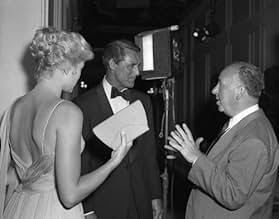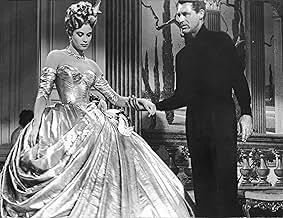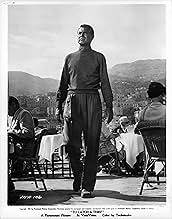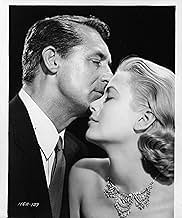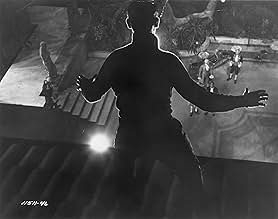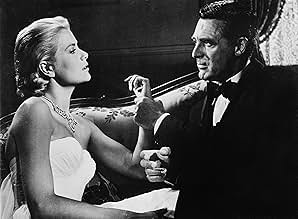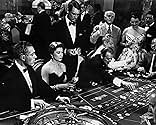Un voleur de bijoux à la retraite cherche à prouver son innocence après avoir été soupçonné de vol.Un voleur de bijoux à la retraite cherche à prouver son innocence après avoir été soupçonné de vol.Un voleur de bijoux à la retraite cherche à prouver son innocence après avoir été soupçonné de vol.
- Réalisation
- Scénario
- Casting principal
- Récompensé par 1 Oscar
- 1 victoire et 5 nominations au total
George Adrian
- Detective
- (non crédité)
John Alderson
- Detective at the Costume Ball
- (non crédité)
Martha Bamattre
- Kitchen Helper
- (non crédité)
René Blancard
- Commissaire Lepic
- (non crédité)
Eugene Borden
- French Waiter
- (non crédité)
Nina Borget
- Frenchwoman
- (non crédité)
George Boyce
- Party Guest
- (non crédité)
John Breen
- Party Guest
- (non crédité)
Margaret Brewster
- Cold-cream Woman
- (non crédité)
Ralph Brooks
- Casino Patron
- (non crédité)
Résumé
Reviewers say 'To Catch a Thief' is celebrated for its cinematography, vibrant colors, and picturesque French Riviera locations. Cary Grant and Grace Kelly's chemistry and performances are highly praised. However, some find the plot less engaging and the suspense lacking compared to other Hitchcock films. The lighter tone and romantic elements receive mixed opinions, while the beautiful costumes and set designs are standout features.
Avis à la une
This is probably Hitchcock's most beautiful movie. Grace Kelly is well (but of course decorously) displayed in delicate and perfectly fitted summer dresses and evening gowns (designed by Edith Head) that show off her exquisite arms and shoulders while accentuating her elegant neck and jaw line--and, as she turns for the camera, the graceful line of her back. Opposite her is one of Hollywood's most dashing leading men, the incomparable Cary Grant.
The cinematography by long-time Hitchcock collaborator Robert Burks was shot on location in the French Riviera. The style is daylight clear and sparkling, bright as the dream of a princess to be, always focused without a hint of darkness anywhere. Even the scenes shot at night on the rooftops seem to glow. The houses on the hills overlooking Princess Grace's future home and the narrow cobble stone roads with the low-lying stone walls suggest a refined and elegant lifestyle to come. Even though she drives too fast, one is not worried that she might crash...
Cary Grant is John Robie who fought with the French resistance during WWII and then became a jewel thief, dubbed "The Cat" for his ability to slink quietly in the night over roof tops and to steal into the bedrooms of the rich and take their jewels without waking them. As the movie opens he is retired from his life of crime and living comfortably in a villa in the hills above Nice. The complications begin immediately as the police arrive at his villa to question him about some recent cat-like jewel robberies. Robie is innocent of course (we are led to believe) and to prove his innocence he is motivated to find the real thief.
Grace Kelly plays Frances Stevens, the slightly naughty nouveau riche daughter of the widow of a Texas-style oil millionaire. She is used to having men fall all over themselves trying to court her, but Robie seems uninterested, and this excites her fancy and she goes after him. It is interesting to note that by this time Cary Grant (51 when the film was released) had become such a heart throb that directors liked to have the women (who were always noticeably younger; Kelly was 26) chase after him. Audrey Hepburn does as much in Charade (1963). One notes that here, as in Charade, the women kiss Cary Grant first, not the other way around. Here it is nicely done as the previously demure Frances takes a surprising initiative at the door of her hotel suite.
The story itself is rather bland and predictable, reminding me of a James Bond flick from, say, the sixties as though toned down for an audience of old maids. Notable in supporting roles are Brigitte Auber as the athletic Danielle Foussard, John Williams as the British insurance agent, and Jessie Royce Landis as Frances Stevens' mother. Hitch makes his de rigueur appearance as a passenger on the mini-bus that Robie takes to get away from the gendarmes early in the film.
See this for Grace Kelly whose cool and playful demeanor and statuesque beauty form the heart of this somewhat languid romantic thriller.
(Note: Over 500 of my movie reviews are now available in my book "Cut to the Chaise Lounge or I Can't Believe I Swallowed the Remote!" Get it at Amazon!)
The cinematography by long-time Hitchcock collaborator Robert Burks was shot on location in the French Riviera. The style is daylight clear and sparkling, bright as the dream of a princess to be, always focused without a hint of darkness anywhere. Even the scenes shot at night on the rooftops seem to glow. The houses on the hills overlooking Princess Grace's future home and the narrow cobble stone roads with the low-lying stone walls suggest a refined and elegant lifestyle to come. Even though she drives too fast, one is not worried that she might crash...
Cary Grant is John Robie who fought with the French resistance during WWII and then became a jewel thief, dubbed "The Cat" for his ability to slink quietly in the night over roof tops and to steal into the bedrooms of the rich and take their jewels without waking them. As the movie opens he is retired from his life of crime and living comfortably in a villa in the hills above Nice. The complications begin immediately as the police arrive at his villa to question him about some recent cat-like jewel robberies. Robie is innocent of course (we are led to believe) and to prove his innocence he is motivated to find the real thief.
Grace Kelly plays Frances Stevens, the slightly naughty nouveau riche daughter of the widow of a Texas-style oil millionaire. She is used to having men fall all over themselves trying to court her, but Robie seems uninterested, and this excites her fancy and she goes after him. It is interesting to note that by this time Cary Grant (51 when the film was released) had become such a heart throb that directors liked to have the women (who were always noticeably younger; Kelly was 26) chase after him. Audrey Hepburn does as much in Charade (1963). One notes that here, as in Charade, the women kiss Cary Grant first, not the other way around. Here it is nicely done as the previously demure Frances takes a surprising initiative at the door of her hotel suite.
The story itself is rather bland and predictable, reminding me of a James Bond flick from, say, the sixties as though toned down for an audience of old maids. Notable in supporting roles are Brigitte Auber as the athletic Danielle Foussard, John Williams as the British insurance agent, and Jessie Royce Landis as Frances Stevens' mother. Hitch makes his de rigueur appearance as a passenger on the mini-bus that Robie takes to get away from the gendarmes early in the film.
See this for Grace Kelly whose cool and playful demeanor and statuesque beauty form the heart of this somewhat languid romantic thriller.
(Note: Over 500 of my movie reviews are now available in my book "Cut to the Chaise Lounge or I Can't Believe I Swallowed the Remote!" Get it at Amazon!)
Like most of Hitchcock this is a film that withstands repeated viewings. A light crime farce it is nevertheless full of great Hitchcock touches- a particular favorite of mine is the chase through the flower market with Cary Grant's comic encounter with the old flower seller. Grace Kelly was perhaps the sexiest of all movie stars in that she could combine the glamor of a Katherine Hepburn or Elizabeth Taylor with the earthy sexiness of Marilyn Monroe. Witness her first surprise kiss with Cary Grant and his reaction. This is priceless acting and one of the reasons Grant is considered one of the greatest actors in movie history. John Williams is also excellent as the very British insurance agent and Jesse Royce Landis (who played Grant's mother in North by Northwest ) is also on hand for a number of fine moments. Although slim in terms of drama this has to rank among the top ten of Hitch's films.
In between his suspense masterpieces,Alfred Hitchcock sometimes liked to work on less intense projects,and this is one of them.There isn't much opportunities for palm-sweating tension or balletically-composed thrills as you'd expect from old Hitch,but in TO CATCH A THIEF this seems quite deliberate.The intention from the very start is partaking in a light comedy-thriller,and on this level it is very enjoyable.And accomplished performers such as Cary Grant,Grace Kelly,Jessie Royce Landis and John Williams further help to give it further resonance and quality.The one disappointment in the film is it's slow pace.There are some parts in the film that drag and produce lethargy,but the beautiful locations,photography and cast save it,including a witty and sometimes surprisingly risqué script which caused some concern from censors at the time.Grant and Kelly rank as one of the best romantic couples ever on screen,and rub genuine sparks off each other.Even at 50 years old,Grant is as handsome,if not more handsome,than he ever was previously,and also looks amazingly lithe,agile and fit,as befits a retired cat burglar,and despite being almost double Grace Kelly's age,is wholly convincing as her suitor.Grace herself never looked more alluring and ravishing,and Jessie Royce Landis and John Williams provide fine support.Williams himself is barely a year older than Grant,yet you wouldn't suspect that at all when they're together on screen,and how ludicrous it is compared to Grant when towards the film's end Kelly puts a relieved head on his shoulder(even Williams himself seems embarrassed!).Such is Grant's eternal youthfulness that Miss Landis played his mother in the superior NORTH BY NORTHWEST(1959);the fact is she's a few months younger than Cary!
There's a well-known tragic coda to the film;the later titled Princess Grace of Monaco lost her life in a car accident on the very same stretches of road that Hitchcock filmed a chase sequence,but barring this sad fact TO CATCH A THIEF is still very decent Hitchcock,not great Hitchcock.But very decent Hitchcock is still far better than 95% of other directors,so there's no problem in watching and enjoying this film.
There's a well-known tragic coda to the film;the later titled Princess Grace of Monaco lost her life in a car accident on the very same stretches of road that Hitchcock filmed a chase sequence,but barring this sad fact TO CATCH A THIEF is still very decent Hitchcock,not great Hitchcock.But very decent Hitchcock is still far better than 95% of other directors,so there's no problem in watching and enjoying this film.
This Hitchcock movie is not about suspense. It is about Grace Kelly, Cary Grant and the French Riviera. If you don't worry about the plot and just watch THEM, you will enjoy it immensely. Hitchcock went through what I call his "travelogue phase" which consisted of Dial M for Murder (London), Vertigo (San Francisco), North by Northwest (Mount Rushmore), and, here, The French Riviera. I consider this phase the time of his masterworks (before he became fixated on the macabre) and although this particular movie is the most insipid of the lot, it is his finest travelogue. For Americans of this period, the mention of Europe must have invoked black and white images of war. Not here!! One really wishes he could take a time machine back to this gloriously beautiful time and place. A movie that can enjoyably be watched time and again. However, I do agree with others that Grant was somewhat miscast as a thief -- even a high-class one.
Alfred Hitchcock is really having fun here, and so are Cary Grant and Grace Kelly. The Mediterranean coast is a stunning backdrop for their gorgeous outdoor scenes, and the great director leads us around the mystery at the heart of this story by alternating between tense chases, high-toned sexual innuendo, and moments of levity. Not to be missed.
Le saviez-vous
- AnecdotesCary Grant had announced his retirement from acting in February 1953, stating that, since the rise of Method actors like Marlon Brando, most people were no longer interested in seeing him. He was also angry at the way Sir Charles Chaplin had been treated by the HUAC. He was lured out of his retirement to make this movie, and thereafter continued acting for a further eleven years.
- GaffesOn the list of jewelry owners, the room number of Mrs. Jessie Stevens is given as 541, but when John Robie accompanies Mrs. Stevens and her daughter to their rooms, the numbers on their doors are 625 and 623, respectively.
- Citations
Frances Stevens: Mother, the book you're reading is upside down!
- Crédits fousThe opening title sequence shows the window of a travel agent, with the text of the titles superimposed. The bottom of the window is not quite horizontal because the window is seen from a slight angle to perpendicular. The text of the titles is given slight parallelogram distortion so the bottom line of text is parallel to the window-sill, and therefore it is not horizontal and parallel with the film frame.
- ConnexionsEdited into Histoire(s) du cinéma: Seul le cinéma (1994)
Meilleurs choix
Connectez-vous pour évaluer et suivre la liste de favoris afin de recevoir des recommandations personnalisées
Détails
- Date de sortie
- Pays d’origine
- Langues
- Aussi connu sous le nom de
- Para atrapar al ladrón
- Lieux de tournage
- 335 Route de Saint-Jeannet, St Jeannet, France(John Robie's villa)
- Société de production
- Voir plus de crédits d'entreprise sur IMDbPro
Box-office
- Budget
- 2 500 000 $US (estimé)
- Montant brut mondial
- 7 117 $US
- Durée1 heure 46 minutes
- Couleur
- Rapport de forme
- 1.85 : 1
Contribuer à cette page
Suggérer une modification ou ajouter du contenu manquant

Lacune principale
By what name was La main au collet (1955) officially released in India in Hindi?
Répondre






